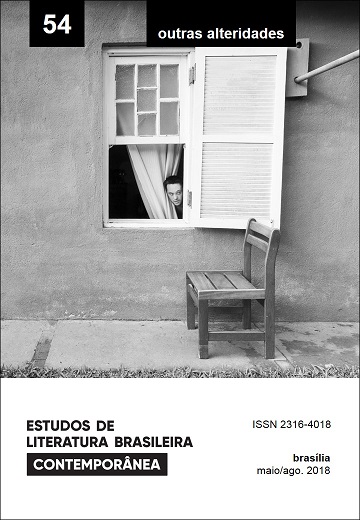Turismo para cegos:
old and new symbolisms in a literary work on blindness
DOI:
https://doi.org/10.1590/10.1590/2316-4018544Abstract
Turismo para cegos, the debut novel by Tércia Montenegro, is yet another text that joins the long tradition of literary works that rely on the presence of blind characters. In this article, we revisit the values and beliefs that fuel the representation of blindness in Western literature, while also pinpointing some of the most common stereotypes associated with blind characters in literary works, in order to analyze the novel in question. In addition, we use Erving Goffman’s theory of stigma to study the intricate theater of relationships established between the blind protagonist and the novel’s other characters. We conclude that, despite perpetuating negative stereotypes, Turismo para cegos also innovates by demystifying the stigmatized figure, elevating it to the status of a complete human being, as faulty as any other.
Downloads
References
ABRAMS, Thomas (2014). Re-reading Erving Goffman as an emancipatory disability researcher. Disability Studies Quarterly, Toledo, v. 34, n. 1
GOFFMAN, Erving (1988). Estigma: notas sobre a manipulação da identidade deteriorada. Tradução de Mathias Lambert. Rio de Janeiro: LCT.
KIRTLEY, Donald D. (1975). The psychology of blindness. Chicago: Nelson-Hall.
MAROS, Angieli (2015). Tércia Montenegro estreia com romance em que “cega” o leitor. Gazeta do Povo, Literatura, 11 abr. On-line. Disponível em: <https://goo.gl/G2te1T>. Acesso em: 10 maio 2017.
MARTINS, Bruno S. (2006). E se eu fosse cego? Narrativas silenciadas da deficiência. Porto: Afrontamento.
MONBECK, Michael (1973). The meaning of blindness: attitudes toward blind people. Bloomington: Indiana University Press.
MONTENEGRO, Tércia (2015). Turismo para cegos. São Paulo: Companhia das Letras.
SOBOTA, Guilherme (2015). Primeiro romance de Tércia Montenegro discute crueldade e sofrimento. Estadão, Cultura, 16 maio. On-line. Disponível em: <https://goo.gl/eJ87qY>. Acesso em: 10 maio 2017.
SPRATT, Adrian (2015). Time to move past memoir. Site pessoal. On-line. Disponível em: <http://adrianspratt.com/essays/>. Acesso em: 20 set. 2016.
STEIN, Deborah Kent (1990). Shackled imagination: literary illusions about blindness. The braille monitor, v. 33, n. 1, Jan. Disponível em: <https://nfb.org/images/nfb/publications/bm/bm90/brlm9001.htm#12>. Acesso em: 29 mai. 2017.
TWERSKY, Jacob (1955). Blindness in literature: examples of depictions and attitudes. New York: American Foundation for the Blind.
WELLS, Herbert G. (1911). The country of the blind. In: WELLS, H. G. The country of the blind and other stories. Nashville: Thomas Nelson and Sons. Disponível em: <http://www.online-literature.com/wellshg/3/>. Acesso em: 21 mai. 2008.
Published
How to Cite
Issue
Section
License
Authors who publish in this journal agree to the following terms:
a) The authors maintain the copyright and grant the journal the right of first publication, the work being simultaneously licensed under the Creative Commons Attribution License-Non Commercial 4.0 which allows the sharing of the work with acknowledgment of the authorship of the work and publication this journal.
b) Authors are authorized to enter into additional contracts separately, for non-exclusive distribution of the version of the work published in this journal (eg publish in institutional repository or as a book chapter), with authorship recognition and publication in this journal.
c) Authors are allowed and encouraged to publish and distribute their work online (eg in institutional repositories or on their personal page) after the editorial process, as this can generate productive changes, as well as increase the impact and citation of published work (See The Effect of Free Access).
d) The authors of the approved works authorize the magazine to, after publication, transfer its content for reproduction in content crawlers, virtual libraries and the like.
e) The authors assume that the texts submitted to the publication are of their original creation, being fully responsible for their content in the event of possible opposition by third parties.


